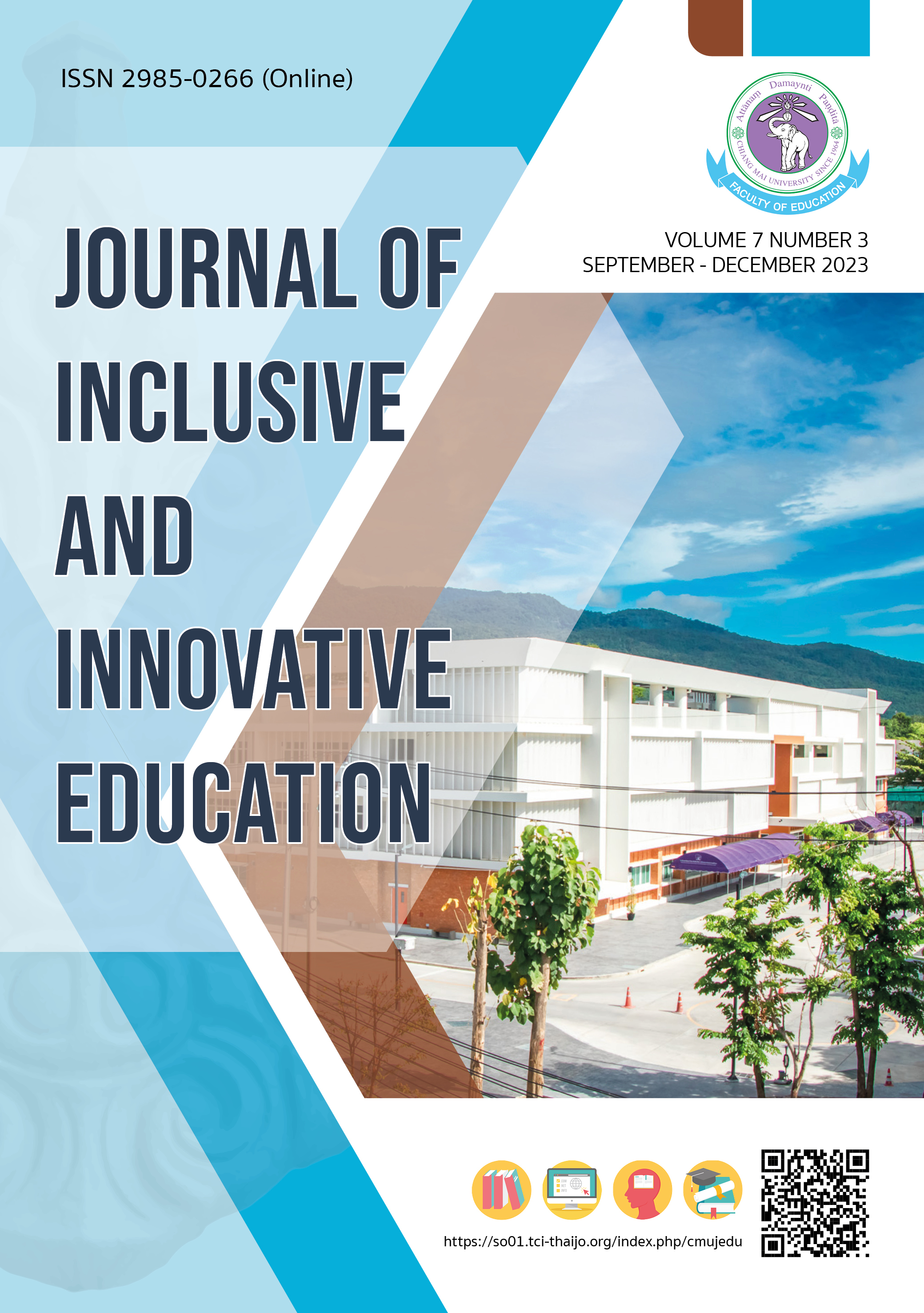การศึกษาความสัมพันธ์และการตรวจสอบความตรงของโมเดลสมรรถนะการปฏิบัติเพื่อสิ่งแวดล้อมของนักเรียนชั้นมัธยมศึกษาปีที่ 6
Main Article Content
บทคัดย่อ
สมรรถนะการปฏิบัติเพื่อสิ่งแวดล้อมเป็นผลลัพธ์การเรียนรู้ด้านสิ่งแวดล้อมศึกษาที่สำคัญในการเตรียมพลเมืองในการรับมือกับปัญหาสิ่งแวดล้อม และสร้างความยั่งยืนให้เกิดขึ้นกับสิ่งแวดล้อม สังคม และเศรษฐกิจ งานวิจัยที่ผ่านมาพบว่านักวิจัยหลายคนได้เสนอองค์ประกอบของสมรรถนะการปฏิบัติเพื่อสิ่งแวดล้อม แต่ยังไม่พบงานวิจัยที่ทำการทดสอบความสัมพันธ์ระหว่างองค์ประกอบต่าง ๆ รวมทั้งงานวิจัยที่ทดสอบความตรงเชิงโครงสร้างของโมเดลสมรรถนะการปฏิบัติเพื่อสิ่งแวดล้อม ดังนั้นงานวิจัยนี้จึงมีเป้าหมายเพื่อศึกษาในเรื่องดังกล่าว กลุ่มตัวอย่างคือนักเรียนชั้นมัธยมศึกษาปีที่ 6 จำนวน 191 คน ที่ได้จากการสุ่มแบบชั้นภูมิ ข้อมูลถูกเก็บรวบรวมโดยใช้แบบวัดสมรรถนะการปฏิบัติเพื่อสิ่งแวดล้อม แบบมาตราส่วนประมาณค่า 3 ระดับ ครอบคลุม 6 องค์ประกอบของสมรรถนะการปฏิบัติเพื่อสิ่งแวดล้อม แบบวัดมีค่าสัมประสิทธิ์ความเชื่อมั่นเท่ากับ 0.87 ผู้วิจัยวิเคราะห์ข้อมูลด้วยสถิติสัมประสิทธิ์สหสัมพันธ์แบบเพียร์สันและการวิเคราะห์องค์ประกอบ เชิงยืนยัน ผลการวิจัยพบว่าองค์ประกอบของสมรรถนะการปฏิบัติเพื่อสิ่งแวดล้อมมีความสัมพันธ์ในทิศทางบวก และโมเดลสมรรถนะการปฏิบัติเพื่อสิ่งแวดล้อมมีความสอดคล้องกลมกลืนกับข้อมูลเชิงประจักษ์ (p-value = 0.074, X2/df=1.743, CFI=0.987, TLI=0.978, RMSEA=0.062) นอกจากนี้พบว่าทักษะการคิดที่นำไปสู่การปฏิบัติเป็นองค์ประกอบที่มีค่าน้ำหนักมากที่สุด คือ 0.81 งานวิจัยนี้จึงเสนอแนะว่าการพัฒนาสมรรถนะการปฏิบัติเพื่อสิ่งแวดล้อมควรเปิดโอกาสให้ผู้เรียนได้ใช้ทักษะการคิดที่นำไปสู่การปฏิบัติ ในที่นี้คือการคิดอย่างมีวิจารณญาณและการสะท้อนความคิด ในระหว่างที่นักเรียนลงมือแก้ไขปัญหาสิ่งแวดล้อม
Article Details

อนุญาตภายใต้เงื่อนไข Creative Commons Attribution-NonCommercial-NoDerivatives 4.0 International License.
หากผู้เสนอบทความมีความจำเป็นเร่งด่วนในการตีพิมพ์โปรดส่งลงตีพิมพ์ในวารสารฉบับอื่นแทน โดยกองบรรณาธิการจะไม่รับบทความหากผู้เสนอบทความไม่ปฏิบัติตามเงื่อนไขและขั้นตอนที่กำหนดอย่างเคร่งครัด ข้อมูลของเนื้อหาในบทความถือเป็นลิขสิทธิ์ของ Journal of Inclusive and Innovative Education คณะศึกษาศาสตร์ มหาวิทยาลัยเชียงใหม่
เอกสารอ้างอิง
Almers, E. (2013). Pathways to action competence for sustainability-six themes. The Journal of Environmental Education, 44(2), 116-127.
Bartz, A.E. (1999). Basics statistical concepts (4th ed.). New Jersey: Prentice Hall.
Breiting, S., & Mogensen, F. (1999). Action competence and environmental education. Cambridge Journal of Education, 29(3), 349-353.
Ceaser, D. (2012). Our school at blair grocery: A case study in promoting environmental action through critical environmental education. The Journal of Environmental Education, 43(4), 209-226.
Gottlieb, D., Vigoda-Gadot, E., & Haim, A. (2013). Encouraging ecological behaviors among students by using the ecological footprint as an educational tool: A quasi-experimental design in a public high school in the city of Haifa. Environmental Education Research, 19(6), 844-863.
Hair, J. F., Black, W. C., Babin, B. J., & Anderson, R. E. (2010). Multivariate Data Analysis. (7th ed.). Pearson: New York.
Jensen, B. B., & Schnack, K. (1997). The action competence approach in environmental education. Environmental Education Research, 3(2), 163-178.
Ketsing, J. Ketchanok, S., & Channakorn, S. (2023). Action competence for environment: New perspective of learning outcome in environmental education. Journal of Education, Prince of Songkla University, Pattani Campus, 34(1), 1-19. [in Thai]
Li, D., & Chen, J. (2015). Significant life experiences on the formation of environmental action among Chinese college students. Environmental Education Research, 21(4), 612-630.
Maartensson, H. & Loi, N.M. (2022). Exploring the relationships between risk perception, behavioral willingness, and constructive hope in pro-environmental behaviour. Environmental Education Research, 28(4), 600-613.
McGrath, M. (2022, 20 November). Climate change: Five key takeaways from COP27. Retrieved from https://www.bbc.com/news/science-environment-63693738.
Mezirow, J. (1985). Concept and action in adult education. Adult Education Quarterly, 35(3), 142-151.
Olsson, D., Gericke, N., & Boeve-de Pauw, J. (2022). The effectiveness of education for sustainable development revisited – a longitudinal study on secondary students’ action competence for sustainability. Environmental Education Research, 28(3), 405-429.
Olsson, D., Gericke, N., Sass, W., & Boeve-de Pauw, J. (2020). Self-perceived action competence for sustainability: the theoretical grounding and empirical validation of a novel research instrument. Environmental Education Research, 26(5), 742-760.
Panarach, Y. (2021). Statistics for education research. Bangkok: Chulalongkorn university press. [in Thai]
Piasentin, F. B., & Roberts, L. (2018). What elements in a sustainability course contribute to paradigm change and action competence? a study at Lincoln university, New Zealand. Environmental Education Research, 24(5), 694-715.
Sarmento, R. P., & Costa, V. (2019). Confirmatory factor analysis--a case study. Retrieved from https://arxiv.org/pdf/1905.05598.pdf.
Sass, W., Claes, E., Boeve-de Pauw, J., De Maeyer, S., Schelfhout, W., Van Petegem, P. & Isac, M.M. (2022). Measuring professional action competence in education for sustainable development (PACesd). Environmental Education Research, 28(2), 260-275.
Sass, W., Pauw, J. B.-d., Maeyer, S. D., & Petegem, P. V. (2021). Development and validation of an instrument for measuring action competence in sustainable development within early adolescents: the action competence in sustainable development questionnaire (ACiSD-Q). Environmental Education Research, 27(9), 1284-1304.
Silo, N. (2013). Dialogue-missing in action competence: A cultural historical activity theory approach in a Botswana school. The Journal of Environmental Education, 44(3), 159-179.
Thongkhumchuenvivat, J. (2010). People in Bangkok’s knowledge, attitude and biological agent used behavior for environmental development. Chandrakasem Rajabhat university Journal, 16(31), 64-74. [in Thai]
United Nations. (2015). Transforming our world: The 2030 agenda for sustainable development. New York: United Nations, Department of Economic and Social Affairs.
Verhelst, D. Vanhoof, J., De Maeyer, S., Sass, W. & Van Petegem, P. (2022). Enabling effective education for sustainable development: Investigating the connection between the school organization and students’ action competence. The Journal of Environmental Education, 53(4), 171-185.
Zhan, Y., He, R., & So, W. W. M. (2019). Developing elementary school children’s water conversation action competence: a case study in China. International Journal of Early Years Education, 27(3), 287-305


